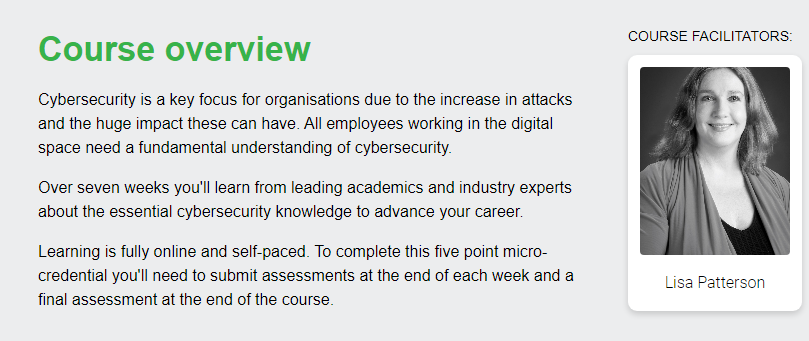The personal wiki of ...
Homepage of Ian
You could do this short course we have developed, an introduction to cybersecurity, taught by one of our staff members.
https://wellingtonuni-professional.nz/micro-credential-cybersecurity-essentials/
 There are also a load of other resources that are worth checking out that point to a tonne of security information depending on where you are thinking of working:
1) Simon Howard (founder of one of the big local security companies) -
https://www.linkedin.com/pulse/getting-started-penetration-tester-nz-2023-edition-simon-howard/
There are also a load of other resources that are worth checking out that point to a tonne of security information depending on where you are thinking of working:
1) Simon Howard (founder of one of the big local security companies) -
https://www.linkedin.com/pulse/getting-started-penetration-tester-nz-2023-edition-simon-howard/
2) Grace's notes on being a security engineer:
https://github.com/gracenolan/Notes/blob/master/interview-study-notes-for-security-engineering.md
3) Awesome Info Sec list where people share links related to range of career into on information security:
https://github.com/binarymist/awesome-infosecnz
Lock Picking
Grant writing
Saturday10December
Waiata and Karakia
Planning Resources
Teaching and Assessment
Resources for PhD, Masters and 489
Various cybersecurity teaching and research resources
DigitalArchiving
MetaData2014
Cybrospace 2013
OfficeHours
PeeringProject
SummerScholarships2011
Android Programming
MobilePython
SCIE302
PC4G-2012
ACSW_AISC2014
 There are also a load of other resources that are worth checking out that point to a tonne of security information depending on where you are thinking of working:
1) Simon Howard (founder of one of the big local security companies) -
https://www.linkedin.com/pulse/getting-started-penetration-tester-nz-2023-edition-simon-howard/
There are also a load of other resources that are worth checking out that point to a tonne of security information depending on where you are thinking of working:
1) Simon Howard (founder of one of the big local security companies) -
https://www.linkedin.com/pulse/getting-started-penetration-tester-nz-2023-edition-simon-howard/
| Cyber security events, podcasts & books, YouTube channels, cyber security skills, artificial intelligence tools, technical writing, CTF & bug bounties resources |
| Contribute to binarymist/awesome-infosecnz development by creating an account on GitHub. github.com |
| I | Attachment | Action | Size | Date |
Who | Comment |
|---|---|---|---|---|---|---|
| |
Great guidance on exams.pdf | manage | 139 K | 27 Apr 2022 - 16:56 | Main.ian | |
| |
7dbb85498ece8559a6e399b43af77794.png | manage | 78 K | 15 Dec 2023 - 11:21 | Main.ian | Auto-attached by ImagePlugin |
| |
99d6a65225f47b067b0b2748b4e5105e.png | manage | 549 K | 15 Dec 2023 - 11:21 | Main.ian | Auto-attached by ImagePlugin |



 Users/Ian
Users/Ian
